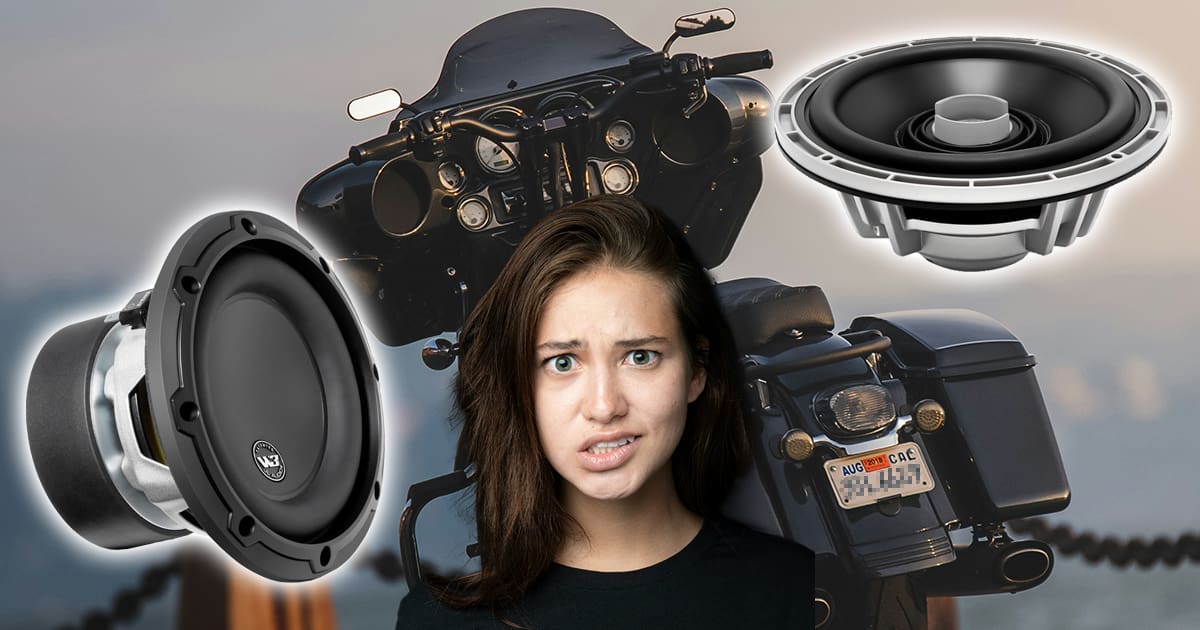We were recently talking with the owner of a motorcycle audio manufacturer. He mentioned that consumers seem to struggle with the concept that relatively small motorcycle speakers cannot produce large amounts of bass. In this context, a small speaker is something you’d find in the fairing or saddlebag on a motorcycle. By comparison, a large speaker would be an 8- or 10-inch subwoofer. Let’s look at how speakers work to explain why some are good for bass and others are best for midrange applications.
Speaker Design – Subwoofer or Midrange
This article will discuss 6.5-inch speakers, common in cars, trucks, motorcycles and boats. Let’s examine the predicted output response of two popular 6.5-inch speakers. The yellow trace is a JL Audio 6W3v3 subwoofer and the red is a Cicada Audio CX65.4 motorcycle audio midrange driver. We chose these drivers because their Thiele/Small parameters are readily available.
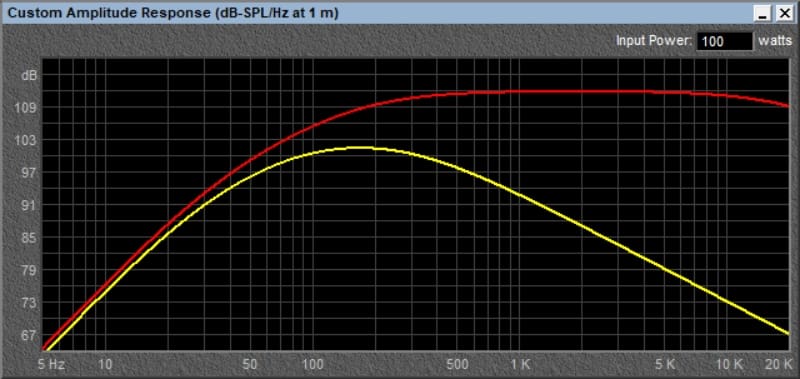
Throughout this article, we’ll unravel a few critical things about this simulation. The response graph you see here isn’t accurate below 100 hertz. Don’t fret; we’ll explain.
Frequency Response Considerations
The first data we want to analyze from the graph is the difference in midrange output. The Cicada Audio speaker (in red) shows good output through most of the audible range. The JL Audio subwoofer starts to roll off its output above 200 hertz.
First, we must clarify a crucial design decision for a speaker that plays a range of frequencies compared with a driver designed exclusively for bass duties. We’ll start with the mass of the woofer cone. The cone must be relatively light for a speaker to respond to signals up to 8 or 10 kHz. A midrange driver might have a moving mass specification of 10 to 15 grams. This would include the cone’s mass, the voice coil former and winding, half of the surround and half of the spider.
The moving mass specification for a subwoofer might be 50 grams. The increased mass adds inertia, making the cone harder to accelerate. The motor (voice coil winding and magnet) won’t be able to move the cone back and forth at high frequencies.
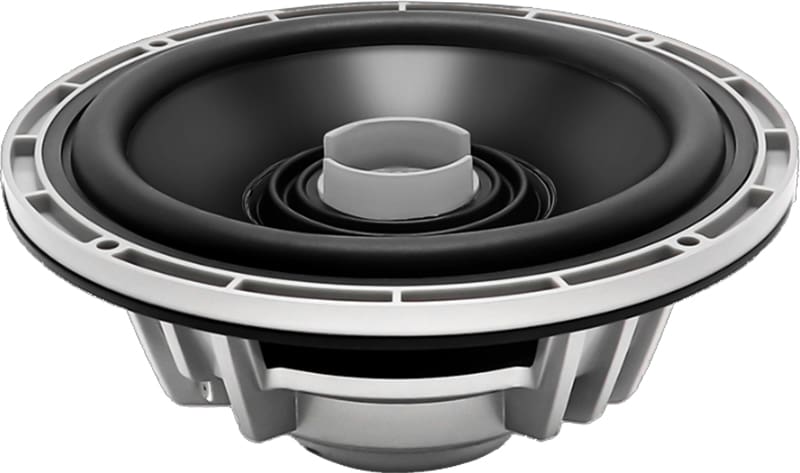
Voice Coil Inductance
The second item that affects high-frequency output is voice coil inductance. We’ve explained that an inductor opposes changes in current flow. For alternating current audio signals, high frequencies change direction thousands of times a second.
A speaker must have a large voice coil to handle large amounts of power. A large voice coil has more inductance and attenuates high-frequency information. The Cicada Audio midrange shown here has a voice coil inductance of 0.03 millihenry. The JL Audio 6W3v3 subwoofer has a voice coil inductance of 1.388 mH. This is logical, given that the winding is at least twice as long and likely has multiple layers.
We Need to Move Air
To reproduce low-frequency information, we need to move a significant amount of air. This means that a speaker needs a considerable amount of cone excursion capability. The Cicada driver, designed primarily for midrange duties, has a voice coil overhand-derived Xmax specification of 4 millimeters. On the other hand, the JL Audio subwoofer has an Xmax specification of 8.89 millimeters.
Let’s multiply those numbers by the effective cone area specification to see how much air the drivers can move. The Cicada can theoretically move 44.8 cubic centimeters of air, while the JL Audio subwoofer can move 107.48, which is 2.4 times as much.
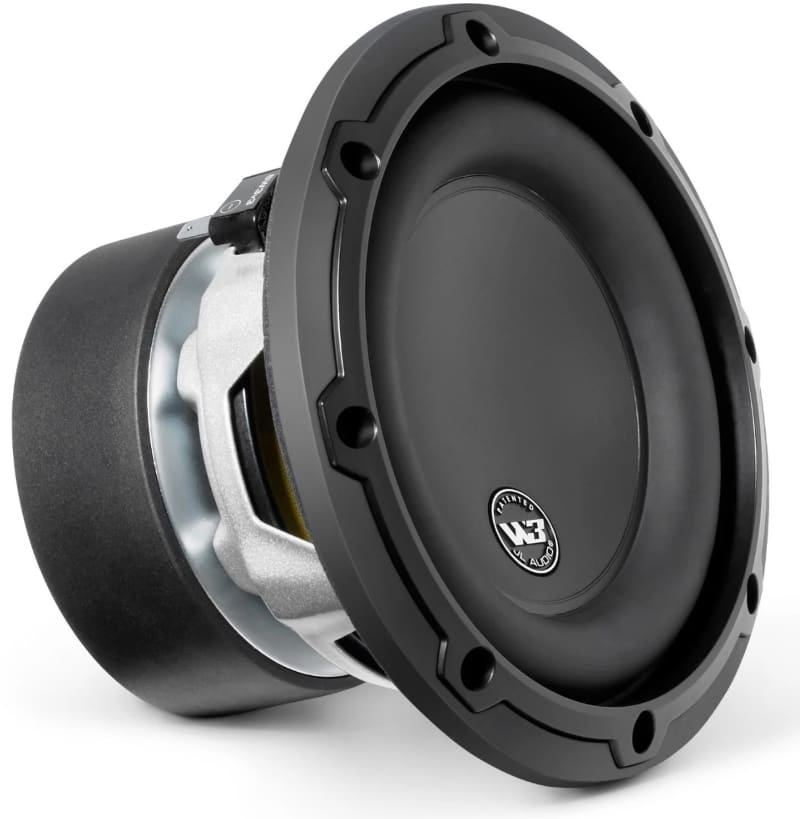
Excursion Limits
Here’s where the frequency response chart above runs into an issue. The graph shows the drivers’ output when fed with 100 watts of power. We must also model the cone excursion behavior to understand a speaker’s suitability for a specific situation.
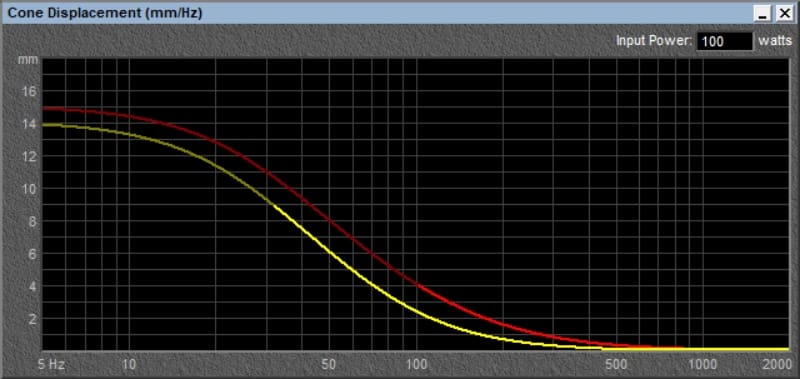
The yellow trace shows us that the subwoofer cone doesn’t move as much for a given amount of power. This correlates back to its mass. However, the 8.89-millimeter Xmax specification tells us the driver will work fine down to just above 30 hertz at this power level. Below that frequency, there will be physical power handling problems.
The Cicada Audio driver is much more efficient. Much of this efficiency comes from the lower moving mass. This is achieved with a much lighter cone and shorter voice coil. Being limited to 4 millimeters of excursion shows that the driver cannot safely play audio frequencies below 100 Hz at a power level of 100 watts.
A drawback for use in another application often offsets every decision in designing a speaker for a specific application. A tweeter won’t produce bass, and a subwoofer won’t produce high frequencies. Midrange drivers might not make much bass or high-frequency information.
No Transfer Function
Now, specific to a discussion about motorcycle audio and powersports speakers, we’re at a considerable disadvantage compared with a car or truck because we don’t have an enclosed vehicle that offers some gain. The interior of a car or truck provides a significant bass boost. In fact, 20 to 30 dB of boost at frequencies below 30 hertz isn’t uncommon. There’s usually 10 dB of boost at 50 Hz. We call this effect cabin gain.
Even a moderately capable small speaker can reproduce a reasonable amount of low-frequency energy in a vehicle. The same happens in our homes. A single good-quality 12-inch subwoofer with 500 or 600 watts of power in a home theater system can give your couch or chair a good shake. It takes dozens of 15- or 18-inch subwoofers and thousands of watts of power at an outdoor concert to reproduce those frequencies at the same volume level.
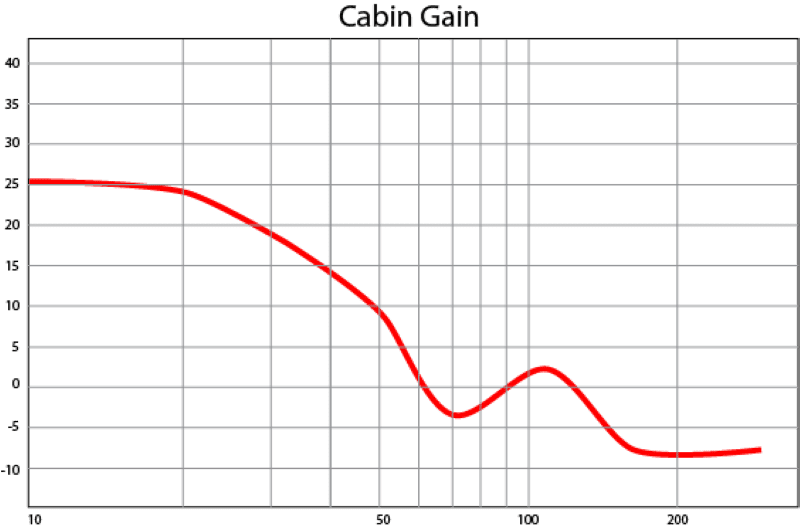
We lack this gain when creating an audio system for a boat, motorcycle or side-by-side. This means our small speakers are on their own to produce usable amounts of bass information. If we want to reproduce bass, we need speakers that can move a significant amount of air. We also likely want to hear vocals and instruments.
Our little circle of performance, however, makes this almost impossible. We need a driver with a large motor and cone assembly to move a lot of air. A large motor assembly is heavy. Heavy cones can’t respond to high-frequency information.
What’s the Solution if We Want Bass?
The answer to getting bass on your motorcycle, boat or side-by-side is to add a subwoofer. It’s not going to rumble like the same-size driver in a car, but it will fill in a lot of the information below 150 hertz. Crucially, having a subwoofer means the small speakers don’t need to try to reproduce bass information. They can focus on midrange frequencies, which means they’ll need a lot less power and will sound much better.
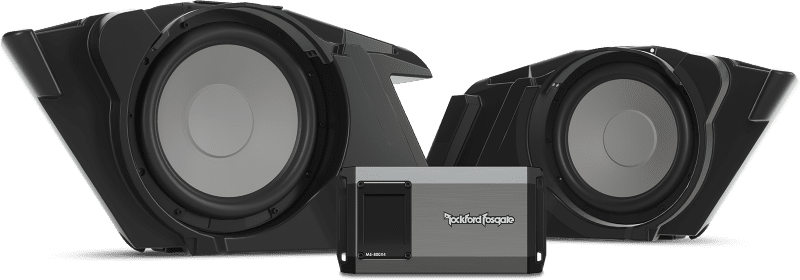
Is One of These Speakers Better Than the Other?
Before anyone thinks that the Cicada Audio or JL Audio speaker is better than the other, we’ll make it perfectly clear that each is designed for a different application. Which is better, a snowmobile or a top-fuel dragster? One is likely better than the other if you are in Alaska. It depends on what you’re trying to do.
The reality is that each speaker is designed for a specific application. JL Audio has many high-performance midrange speakers to accompany its subwoofers. Likewise, Cicada Audio has several woofers designed for motorcycle applications. Choosing the right speaker for your needs is the key to creating a mobile audio system that sounds great. Drop by a local specialty mobile enhancement retailer today and ask them for suggestions about speakers for upgrading your vehicle. Let them know your performance goals, and they’ll design a solution that will sound great!
